V. Armitage / W. F. Eberlein
Elliptic Functions
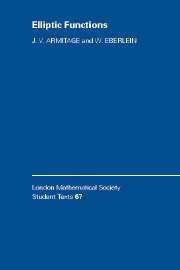 Series: London Mathematical Society Student Texts (No. 67)
Series: London Mathematical Society Student Texts (No. 67)
Paperback (ISBN-13: 9780521785631 | ISBN-10: 0521785634)
Hardback (ISBN-13: 9780521780780 | ISBN-10: 0521780780)
In its first six chapters this text seeks to present the basic
ideas and properties of the Jacobi elliptic functions as an
historical essay, an attempt to answer the fascinating question:
'what would the treatment of elliptic functions have been like if
Abel had developed the ideas, rather than Jacobi?' Accordingly,
it is based on the idea of inverting integrals which arise in the
theory of differential equations and, in particular, the
differential equation that describes the motion of a simple
pendulum. The later chapters present a more conventional approach
to the Weierstrass functions and to elliptic integrals, and then
the reader is introduced to the richly varied applications of the
elliptic and related functions. Applications spanning arithmetic
(solution of the general quintic, the functional equation of the
Riemann zeta function), dynamics (orbits, Euler's equations,
Green's functions), and also probability and statistics, are
discussed.
* The emphasis on applications makes the book suitable for a
lecture course in which students are invited to develop ideas as
a basis for essays or projects ¿ Applications are referred to
throughout and the book concludes with significant applications
in algebra, arithmetic, classical geometry and applied
mathematics ¿ A new look at the Jacobi functions based on a
rigorous treatment of the differential equation for the simple
pendulum and the inversion of integrals
Contents
1. The 'simple' pendulum; 2. Jacobian elliptic functions of a
complex variable; 3. General properties of elliptic functions; 4.
Theta functions; 5. The Jacobian elliptic functions for complex
k; 6. Introduction to transformation theory; 7. The Weierstrass
elliptic functions; 8. Elliptic integrals; 9. Applications of
elliptic functions in geometry; 10. An application of elliptic
functions in algebra solution of the general quintic equation; 11.
An arithmetic application of elliptic functions; 12. Applications
in mechanics and statistics and other topics; Appendix;
Bibliography.
B. Bollobas / Trinity College, Cambridge
O. Riordan / Trinity College, Cambridge
Percolation
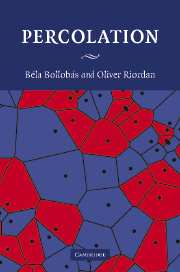 Hardback (ISBN-13: 9780521872324 | ISBN-10: 0521872324)
Hardback (ISBN-13: 9780521872324 | ISBN-10: 0521872324)
Percolation theory was initiated some fifty years ago as a
mathematical framework for the study of random physical processes
such as flow through a disordered porous medium. It has proved to
be a remarkably rich theory, with applications beyond natural
phenomena to topics such as network modelling. The aims of this
book are twofold. First to present classical results in a way
that is accessible to non-specialists. Second, to describe, for
the first time in a book, recent results of Smirnov in conformal
invariance, and outline the proof that the critical probability
for random Voronoi percolation in the plane is 1/2. Throughout,
the presentation is streamlined, with elegant and straightforward
proofs requiring minimal background in probability and graph
theory. Numerous examples illustrate the important concepts and
enrich the arguments. All-in-all, it will be an essential
purchase for mathematicians, physicists, electrical engineers and
computer scientists working in this exciting area.
* Only book that systematically presents probabilistic and graph
theory tools for percolation, and that describes Smirnov's
results in conformal invariance ? Streamlined presentation
requiring only minimal background in probability and graph theory
* Numerous examples illustrate the important concepts and enrich
the arguments
Contents
Preface; 1. Basic concepts; 2. Probabilistic tools; 3.
Percolation on Z2 - the Harris-Kesten Theorem; 4. Exponential
decay and critical probabilities - theorems of Menshikov and
Aizenman & Barsky; 5. Uniqueness of the infinite open cluster
and critical probabilities; 6. Estimating critical probabilities;
7. Conformal invariance - Smirnov's Theorem; 8. Continuum
percolation; Bibliography; Index; List of notation.
Edited by Jesus M. F. Castillo / Universidad de Extremadura
William B. Johnson / Texas A & M University
Methods in Banach Space Theory
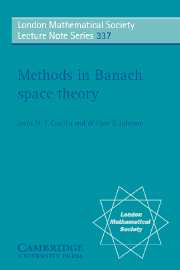 Series: London Mathematical Society Lecture Note Series (No.
337)
Series: London Mathematical Society Lecture Note Series (No.
337)
Paperback (ISBN-13: 9780521685689 | ISBN-10: 0521685680)
This book presents an overview of modern Banach space theory. It
contains sixteen papers that reflect the wide expanse of the
subject. Articles are gathered into five sections according to
methodology rather than the topics considered. The sections are:
geometrical methods; homological methods; topological methods;
operator theoretic methods; and also function space methods. Each
section contains survey and research papers describing the state-of-the-art
in the topic considered as well as some of the latest most
important results. Researchers working in Banach space theory,
functional analysis or operator theory will find much of interest
here.
* Presents overview of modern Banach space theory * Contains most
up-to-date and important results in this topic * Ideal for all
researchers working in Banach space theory, functional analysis
or operator theory
Contents
Acknowledgements; Foreword; Part I. Geometrical Methods: 1.
Saturated extensions, the attractors method and hereditarily
James tree spaces Spiros A. Agyros, Alexander D. Arvanitakis and
Andreas G. Tolias; 2. The Daugavet property for Lindenstrauss
spaces J. Becerra and M. Martin; 3. Weakly null sequences in the
Banach space I. Gasparis, E. Odell and B. Wahl; Part II.
Homological Methods: 4. Yet another proof of Sobczyk's theorem
Felix Cabello Sanchez; 5. The category of exact sequences of
Banach spaces Jesus M. F. Castillo and Yolanda Moreno; 6.
Extension problems for C(K)spaces and twisted sums N. J. Kalton;
7. Palamodov's questions from homological methods in the theory
of locally convex spaces Jochen Wengenroth; Part III. Topological
Methods: 8. Ordinal representability in Banach spaces M. J.
Campion, J. C. Candeal, A. S. Granero and E. Indurain; 9.
Overclasses of the class of Radon-Nikodym compact spaces Marian
Fabian; 10. Convexity, compactness and distances A. S. Granero
and Marcos Sanchez; Part IV. Operator Theory Methods: 11. Weyl's
and Browder's theorems through the quasi-nilpotent part of an
operator Pietro Aiena and Maria Teresa Biondi; 12.
Multiplications and elementary operators in the Banach space
setting Eero Saksman and Hans-Olav Tylli; 13. Interpolation of
Banach spaces by the ?-method Jesus Suarez and Lutz Weis; Part V.
Function Space Methods: 14. Solvability of an integral equation
in BC(R+) J. Caballero, B. Lopez and K. Sadarangani; 15. Harold
Bohr meets Stefan Banach Andreas Defant and Christopher Prengel;
16. Selected problems on the structure of complemented subspaces
of Banach spaces Aleksander Pelczynski; List of participants.
Contributors
Spiros A. Agyros, Alexander D. Arvanitakis, Andreas G. Tolias, J.
Becerra, M. Martin, I. Gasparis, E. Odell, B. Wahl, Felix Cabello
Sanchez, Jesus M. F. Castillo, Yolanda Moreno, N. J. Kalton,
Jochen Wengenroth, M. J. Campion, J. C. Candeal, A. S. Granero, E.
Indurain, Marian Fabian, Marcos Sanchez, Pietro Aiena, Maria
Teresa Biondi, Eero Saksman, Hans-Olav Tylli, Jesus Suarez, Lutz
Weis, J. Caballero, B. Lopez, K. Sadarangani, Andreas Defant,
Christopher Prengel, Aleksander Pelczynski
Richard J. Gardner / Western Washington University
Geometric Tomography, 2nd Edition
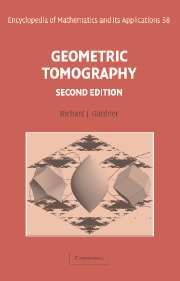 Series: Encyclopedia of Mathematics and its Applications
Series: Encyclopedia of Mathematics and its Applications
Hardback (ISBN-13: 9780521866804 | ISBN-10: 0521866804)
Paperback (ISBN-13: 9780521684934 | ISBN-10: 0521684935)
Geometric tomography deals with the retrieval of information
about a geometric object from data concerning its projections (shadows)
on planes or cross-sections by planes. It is a geometric relative
of computerized tomography, which reconstructs an image from X-rays
of a human patient. The subject overlaps with convex geometry and
employs many tools from that area, including some formulas from
integral geometry. It also has connections to discrete
tomography, geometric probing in robotics and to stereology. This
comprehensive study provides a rigorous treatment of the subject.
Although primarily meant for researchers and graduate students in
geometry and tomography, brief introductions, suitable for
advanced undergraduates, are provided to the basic concepts. More
than 70 illustrations are used to clarify the text. The book also
presents 66 unsolved problems. Each chapter ends with extensive
notes, historical remarks, and some biographies. This new edition
includes numerous updates and improvements, with some 300 new
references bringing the total to over 800.
* Over 70 illustrations * Comprehensive bibliography has over 800
references * Well-written and clear; the opening chapters are
accessible to advanced undergraduates
Contents
0. Background material; 1. Parallel X-rays of planar convex
bodies; 2. Parallel X-rays in n dimensions; 3. Projections and
projection functions; 4. Projection bodies and volume
inequalities; 5. Point X-rays; 6. Chord functions and equichordal
problems; 7. Sections, section functions, and point X-rays; 8.
Intersection bodies and volume inequalities; 9. Estimates from
projection and section functions; A. Mixed volumes and dual mixed
volumes; B. Inequalities; C. Integral transforms.
Alexandra Shlapentokh / East Carolina University
Hilbert's Tenth Problem
Diophantine Classes and Extensions to Global Fields
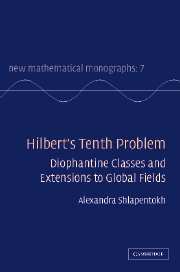 Series: New Mathematical Monographs (No. 7)
Series: New Mathematical Monographs (No. 7)
Hardback (ISBN-13: 9780521833608 | ISBN-10: 0521833604)
In the late sixties Matiyasevich, building on the work of Davis,
Putnam and Robinson, showed that there was no algorithm to
determine whether a polynomial equation in several variables and
with integer coefficients has integer solutions. Hilbert gave
finding such an algorithm as problem number ten on a list he
presented at an international congress of mathematicians in 1900.
Thus the problem, which has become known as Hilbert's Tenth
Problem, was shown to be unsolvable. This book presents an
account of results extending Hilbert's Tenth Problem to
integrally closed subrings of global fields including, in the
function field case, the fields themselves. While written from
the point of view of Algebraic Number Theory, the book includes
chapters on Mazur's conjectures on topology of rational points
and Poonen's elliptic curve method for constructing a Diophatine
model of rational integers over a 'very large' subring of the
field of rational numbers.
* Looks at the subject from the point of view of Algebraic Number
Theory * Also includes information on Mazur's Conjectures and
Poonen's elliptic curve method * Suitable for graduate students
Contents
1. Introduction; 2. Diophantine classes: definition and basic
facts; 3. Diophantine equivalence and diophantine decidability; 4.
Integrality at finitely many primes and divisibility of order at
infinitely many primes; 5. Bound equations for number fields and
their consequences; 6. Units of rings of W-integers of norm 1; 7.
Diophantine classes over number fields; 8. Diophantine
undecidability of function fields; 9. Bounds for function fields;
10. Diophantine classes over function fields; 11. Mazur's
conjectures and their consequences; 12. Results of Poonen; 13.
Beyond global fields; A. Recursion theory; B. Number theory;
Bibliography; Index.
 Series: London Mathematical Society Student Texts (No. 67)
Series: London Mathematical Society Student Texts (No. 67) Hardback (ISBN-13: 9780521872324 | ISBN-10: 0521872324)
Hardback (ISBN-13: 9780521872324 | ISBN-10: 0521872324) Series: London Mathematical Society Lecture Note Series (No.
337)
Series: London Mathematical Society Lecture Note Series (No.
337) Series: Encyclopedia of Mathematics and its Applications
Series: Encyclopedia of Mathematics and its Applications Series: New Mathematical Monographs (No. 7)
Series: New Mathematical Monographs (No. 7)